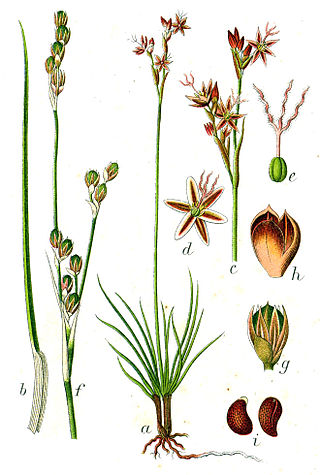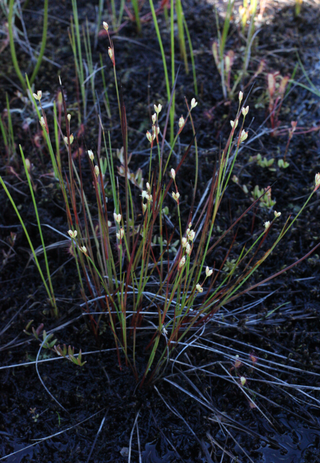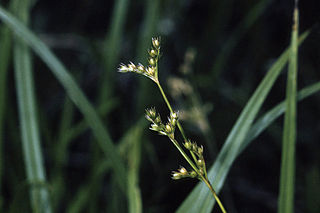
Juncaceae is a family of flowering plants, commonly known as the rush family. It consists of 8 genera and about 464 known species of slow-growing, rhizomatous, herbaceous monocotyledonous plants that may superficially resemble grasses and sedges. They often grow on infertile soils in a wide range of moisture conditions. The best-known and largest genus is Juncus. Most of the Juncus species grow exclusively in wetland habitats. A few rushes, such as Juncus bufonius are annuals, but most are perennials.

Juncus is a genus of monocotyledonous flowering plants, commonly known as rushes. It is the largest genus in the family Juncaceae, containing around 300 species.

Juncus effusus is a perennial herbaceous flowering plant species in the rush family Juncaceae, with the common names common rush or soft rush. In North America, the common name soft rush also refers to Juncus interior.

Juncus bufonius, known commonly as toad rush, is a widespread flowering plant species complex in the rush family Juncaceae.

Juncus acutus, the spiny rush, sharp rush or sharp-pointed rush, is a flowering plant in the monocot family Juncaceae. It is native to the Americas, Northern and Southern Africa, Western and Southern Europe and West Asia, and is found in a variety of wet habitats, such as bogs, fens, meadows, and salt marshes, and along the edges of ponds and lakes.

Juncus balticus is a species of rush known by the common name Baltic rush. It is a perennial flowering plant in the family Juncaceae. It can reach a height of about 75 centimetres. It is native to north-western Europe from Spain to northern European Russia, most of North America except the south-eastern United States, parts of Mexico and Central America, and western and southern South America from Colombia to Argentina. It is available from specialist nurseries for landscaping and soil stabilization purposes.

Juncus scheuchzerioides is a species of rush variously called short rush or greater rush. It has an Antarctic circumpolar distribution and is native to many subantarctic islands in, and on the regions bordering, the Southern Ocean.

Juncus antarcticus, also known as dwarf rush, is a flowering plant species in the rush family Juncaceae, native to New Zealand and Australia.

Juncus compressus is a species of flowering plant in the rush family, Juncaceae. It is native to temperate Eurasia.Juncus compressus is easy to confuse with J. gerardii.

Juncus filiformis, called the thread rush, is a species of flowering plant in the genus Juncus, with a circumboreal distribution. It has been introduced to South Georgia Island. It is typically found in wetlands, on the borders of lakes and streams.

Juncus bulbosus, the bulbous rush, is a species of flowering plant in the family Juncaceae, native to Iceland, the Faroes, Europe, Macaronesia, and northwest Africa. It has been introduced to Australia, New Zealand, and some locations in northern North America. It is capable of nuisance growth in lakes and streams.

Juncus inflexus, the hard rush, is a species of flowering plant in the family Juncaceae, native to Europe, Asia and Africa, and introduced in Sri Lanka, Java, Île Amsterdam and Île Saint-Paul, Victoria in Australia, New Zealand, Uruguay, and eastern North America. It is a glycophyte (non-halophyte).

Juncus squarrosus, called goose corn, heath rush, and mosquito rush, is a species of flowering plant in the family Juncaceae, native to Iceland, Europe, and Morocco, and introduced to Greenland, Svalbard, Tasmania, New Zealand, and the US state of Wisconsin. It is pollution-tolerant.

Juncus alpinoarticulatus, called the northern green rush and the alpine rush, is a species of flowering plant in the genus Juncus, with a circumboreal distribution. It prefers wet sandy soils, peat bogs, acidic fens, and ditches.

Juncus stygius, called the bog rush and moor rush, is a species of flowering plant in the genus Juncus, with a high circumboreal distribution, never reaching further south than Switzerland, Korea and Upstate New York.

Juncus triglumis, called the three-flowered rush, is a species of flowering plant in the genus Juncus, native to the subarctic and subalpine Northern Hemisphere. It is typically found in calcareous tundra habitats and arcto-alpine fens. It is often found in association with Carex atrofusca and Carex bicolor in the so-called Caricion bicolori-atrofuscae alliance.

Juncus canadensis, called the Canadian rush, is a species of flowering plant in the genus Juncus, native to central and eastern Canada and the central and eastern United States, and introduced to Oregon, New Zealand, and the Low Countries in Europe. It is an obligate wetland species.

Juncus scirpoides, the needlepod rush, is a species of flowering plant in the family Juncaceae, native to the central and eastern United States. It prefers wet sandy soils, and among the many places it grows it is common in the enigmatic Carolina bays.

Juncus secundus, the lopsided rush, one-sided rush, or second rush, is a species of flowering plant in the family Juncaceae, native to eastern North America and introduced to Primorsky Krai in Russia. It is typically found in serpentine, granite, and other barrens.
Juncus sect. Tenageia is a section of small annual rushes.


















